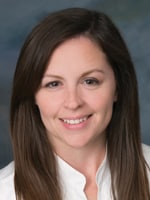November 2022—What labs want and need from their lab information systems and what the missing pieces are in interoperability are what pathologists and LIS company reps talked to CAP TODAY publisher Bob McGonnagle about when they met online Sept. 12.
“The biggest challenge is with device integration” in molecular testing, said J. Mark Tuthill, MD, of Henry Ford Health System. “We have million-dollar instruments and we’re still programming runs manually. We don’t have HL7 order feeds. We don’t have the ability to get result feeds outbound from those devices.”
In microbiology, too, there’s “a tremendous amount of information and little integration,” he said. For more, read on. CAP TODAY’s laboratory information systems product guide begins here.
Jonathon Northover, one of the drivers as we come out of the pandemic is consolidation. What’s top of mind for your customers and potential customers in what they’re looking for from CompuGroup Medical?
Jonathon Northover, vice president of product management, CompuGroup Medical: Number one is offering direct-to-consumer diagnostics, from test kits that the laboratory is responsible for sending to the customers of physicians, to services where someone collects the specimen professionally in the home, to setting up patient service centers for collection. Independent reference laboratories need an end-to-end solution—one that enables patients to order those tests and also provides integration with physician approvals when needed, depending on the type of test or panel or the state they’re in. There’s a lot of growth around patient portals—ordering and receiving results and interacting with the physician.
The second is refactoring PCR instruments to do microbiology testing. COVID testing volumes meant a lot of investment in those instruments. Now that COVID testing has dropped, they want to reuse their PCR instruments to maximize a return on that investment.
Suren Avunjian, can you answer the same question?
Suren Avunjian, founder and chief executive officer, LigoLab Information Systems: A lot of laboratories that were able to scale their volumes during COVID and had the cash flow are now acquiring more laboratories, scaling to multiple states, and repurposing their PCR machines to be able to run a larger variety of molecular testing. A lot of this is applied to and prepared for consumer testing. With the consumer portal, they’re able to attract direct-to-consumer and direct-to-organizational testing. We’re seeing volume starting to pick up on that front. What’s next is the ability for the patients to better understand their reports and be able to have a remote coaching session right out of the patient portal.

Modleski
Matt Modleski, are you seeing similar trends with your customers at Orchard?
Matt Modleski, executive vice president of corporate/business development, Orchard Software: We are. It brings to mind the question about the reimbursement for direct-to-consumer testing and how it fits with a physician office laboratory that wants that revenue. Once the consumer does the testing and insurance pays for it, if it does, how does the second test the doctor wants to order in the office or in their own laboratory get paid, or does it not get paid? It’s an interesting trend we’ll continue to watch.
We thought the pandemic was going to accelerate the adoption of molecular testing across a variety of areas, so we added a molecular business and integrated it with our solution. The question is how fast people can adapt their business model and make it a successful part of their business.
Dayna Carlin, I hear increasingly that a lot of what we call traditional clinical laboratory tests are being performed in pathology departments or in freestanding pathology centers. Is that trend continuing as you see it at NovoPath? And is this brought on by the complexity of cases that pathologists are dealing with today, where they need surgical, molecular, and some clinical pathology results all in the record?
Dayna Carlin, marketing director, NovoPath: Yes, this is a trend we are seeing. At NovoPath we call this segment of the market independent reference labs. We are talking to pathologists daily and hearing how they are looking to escape the hardships of operating in a pathology lab in big health care systems by opening their own independent practices. So it’s an interesting time because we’re seeing a lot of smaller labs forming but also a lot of consolidation. There are several larger labs in this space that have not been acquired by the big players, like the Quests of the world, and those larger labs are instead acquiring small to midsize reference labs. It’s an interesting time.
To your second question, the need to have anatomic and molecular under one house is being driven by the physicians. They already have a lot on their plates and consolidating the number of labs they leverage makes it easier for clinics to operate.
Michael Becich, what are you seeing around the needs that your clinical colleagues have for reporting? What is top of mind for you in terms of improving the IT offering?
Michael J. Becich, MD, PhD, associate vice chancellor for informatics for the health sciences; distinguished university professor and chair, Department of Biomedical Informatics, and interim co-director, Pittsburgh Supercomputing Center, University of Pittsburgh School of Medicine: In the mainstream right now is molecular testing. The lack of deep integration of that testing plus the myriad outsourced molecular tests remains a problem for pathologists in terms of communications to clinicians for decision-making.
The key is to make genomic data flow freely from laboratories doing the testing and the health systems managing the patients. Plus, if we’re going to do precision medicine or oncology in the future, we have to be prepared to keep DNA available on patients as a data mining resource and follow that DNA journey as the patient is tested for transplantation, immune therapies, oncology, or chronic diseases. It is a serious gap in the way pathology is coordinated, not only in large academic meccas but into community practice. In fact, some of the best innovations are in for-profit DNA testing laboratories where they’re realizing this is a way to distinguish themselves and add tremendous value to the patient journey.
Carol Ross of Clinisys, is this in sync with what you’re seeing and trying to do in product management and development?
Carol Ross, MBA, director of product management, Clinisys: Yes, it is. We’re hearing from our customers a lot about molecular and understanding the integration of the testing but not much about direct to consumer.

Webb
Lee Webb of Clinisys, can you comment on the pathology element?
Lee Webb, global product line manager, clinical lab products, Clinisys: As Dr. Becich said, we’re seeing a need for integrated reporting, especially in the anatomic pathology space but not unique to AP, to be able to look at data from different sources, including molecular, images, image analysis data, and bring it together into a centralized reporting mechanism. That includes data from the clinical laboratory as well.
I was just at a conference on cancer biomarkers, and one of the chief concerns from pathologists, reference lab executives, pharma folks, everyone, was how do we get a complete report on a patient into a patient record without creating confusion for the clinician. They said also they have to deal with PDF reports that get put into the record but can’t be edited or integrated with anything. Diana Richard, how are you grappling with that problem at Xifin?
Diana Richard, senior director of pathology and strategic development, Xifin: We’ve tried to build flexibility around our system and Web services so we can return information into either the institution’s own EMR or patient or client portals. If a client has its own patient portal and wants us to funnel information into that versus using the Xifin portal, we have that capability. If the client doesn’t have its own patient portal, we are able to produce test results on our patient portal. A lot of that is driven by application programming interfaces and being able to leverage that technology for this bidirectional format of communication.

Richard
There’s a greater need to consolidate patient records into a single platform, and there are several iterations of that. We have our VisualStrata, which is our clinical data management utility platform. The challenge is, who owns it? The hospital? The pathology group? How do you get the oncologist or radiologist to be willing to share the information? There has to be an agreement and understanding among the specialties in order to make the data aggregation valuable to the hospital for that patient as a whole. We try to control it as best we can from a pathology and laboratory perspective. But it’s a conversation that encompasses multiple specialties, not just ours.
Matt Folsom, do you find yourself engaged in complicated diplomacy with IT and specialty departments?
Matt Folsom, senior director of software engineering for Xifin LIS: We do. And it used to be you could send a PDF report and it was okay. That has changed as the data has become more important than just a PDF document. We find, especially for customers with older platforms, it’s good to have the flexibility to say you can have your test compendium and results in a certain way and have the configurability to translate that message to the EMR so you can get the data where you need it, whether it is in a single field that’s a block of text or discrete result components that you need to send over. We found great success with that—if issues do arise it’s not a matter of an engineering feat; it’s configuring a system to tweak a few bits of data and then things flow fine. We’ve done these implementations before, and we can take what we’ve done as a recommendation to our customers with their existing tests and say, You’re a little different; here is the disparity where we need to focus. We can get you 95 percent of the way there and focus on the last five percent.
Mark Tuthill, what are your top-of-mind challenges as you reflect on this discussion and as you look into the new year, for which I’m sure you’re involved in budget discussions?
J. Mark Tuthill, MD, division head, pathology informatics, Henry Ford Health System: If we go back to molecular diagnostics, the biggest challenge is with device integration. We have million-dollar instruments and we’re still programming runs manually. We don’t have HL7 order feeds. We don’t have the ability to get result feeds outbound from those devices. And when we get results back from our pipelines, the sophistication of either the bioinformatics pipelines or the laboratory information systems are such that the process is still manual: do a molecular test by entering data into the device, get results out, type it into the LIS; or get the report back from the pipeline and cut and paste into the LIS. This is like 1980. We need to get past this. We’re doing a lot of work on that now with LIS and integration partners as well as our molecular lab players to address these challenges.
 CAP TODAY Pathology/Laboratory Medicine/Laboratory Management
CAP TODAY Pathology/Laboratory Medicine/Laboratory Management
